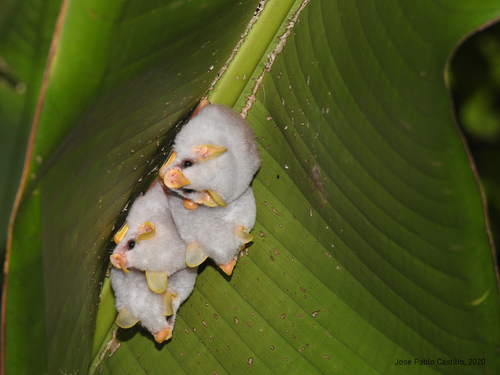
Honduran white bat
The Honduran white bat (*Ectophylla alba*) is a unique and captivating species of bat found in Central America. Unlike many other bat species, it boasts a striking pure white coat and a distinctive leaf-like nose. These tiny bats play a crucial role in their ecosystem as seed dispersers and are known for their unusual roosting behavior, constructing 'tents' out of Heliconia leaves. They hold a special place in the Neotropical rainforests, contributing to the biodiversity and health of these vital habitats. They are not currently considered to hold any particular cultural significance, other than their general appeal due to their unusual and attractive appearance.
3.7-4.7 cm
Length
Approximately 10 cm
Wingspan
Near Threatened
Conservation Status
Distribution
The Honduran white bat is found in the humid lowlands of eastern Honduras, northern Nicaragua, eastern Costa Rica, and western Panama. They are non-migratory, remaining within their tropical rainforest habitats year-round. They generally reside at elevations from sea level up to around 700 meters.
Lifespan
Unknown in the wild; likely several years, typical of small bat species.
Honduran white bat's Habitat
Habitat Types
Lowland rainforests, Areas with Heliconia plants
Climate Zones
Tropical
Adaptations
Their small size and maneuverability are well-suited for navigating the dense understory of the rainforest. Their tent-roosting behavior provides shelter from rain and predators, a unique adaptation to their humid environment.
Variations
No recognized subspecies exist. However, subtle variations in size and coloration may occur across their geographic range, though these are not formally classified.
Appearance
Breeding Plumage
No significant seasonal variation in their white fur.
Seasonal Feather Changes
None
Sex Based Plumage Differences
None; both males and females have white fur.
Notable Features
Pure white fur, Yellow, leaf-shaped nose and ears, Black wing membranes, Small size
Diet and Feeding
Primary Foods
Fruits, primarily of specific fig species (Ficus colubrinae)
Foraging Behavior
Honduran white bats are frugivores, meaning they primarily eat fruit. They forage at night, using their keen sense of smell to locate ripe fruit. They typically pluck the fruit and carry it to a nearby feeding roost.
Specializations
Their specialized diet on a small number of fig species indicates a close ecological relationship with these plants. Their small size allows them to access fruits that may be inaccessible to larger animals.
Seasonal Diet Variations
Their diet is relatively consistent year-round, as their preferred fig species produce fruit throughout the year. However, they may supplement their diet with other fruits when their primary food source is less abundant.
Behavior
Social Structure
Honduran white bats live in small colonies, typically consisting of a single male and a harem of up to six females, along with their offspring. These groups roost together in their leaf tents.
Communication
High-pitched vocalizations (likely used for communication within the tent and during foraging), Olfactory cues (important for locating ripe fruit and possibly for social recognition)
Migration
Non-migratory; they remain within their tropical rainforest habitats year-round.
Territorial or Group Behaviors
The male bat is thought to be territorial, defending the tent roost from other males. The group roosting behavior provides protection from predators and the elements.
Conservation
Threats
Habitat loss due to deforestation, Fragmentation of rainforest habitat, Climate change (potentially affecting fruit availability)
Protection Programs
Protected areas within their range (e.g., national parks and reserves)
Local National Laws
Protected under general wildlife conservation laws in the countries where they occur.
Population Trend
Decreasing
Population Estimates
Population size is difficult to estimate due to their small size and cryptic roosting habits, but it is thought to be declining.
Interesting Facts
They create their own 'tents' by chewing along the veins of Heliconia leaves.
This causes the leaf to fold down, creating a sheltered roosting space.
Their white fur may help them blend in with the filtered light within their leaf tents.
This camouflage may provide protection from predators.
The yellow coloration of their nose and ears comes from carotenoid pigments.
These pigments are obtained from their diet and may play a role in social signaling.
Faqs about Honduran white bat
Are Honduran white bats dangerous to humans?
No, Honduran white bats are harmless to humans. They are small, shy creatures that feed on fruit and play a beneficial role in their ecosystem.
Where can I see Honduran white bats?
They are found in the lowland rainforests of Central America. Observing them in the wild can be challenging due to their small size and nocturnal habits, but visiting protected areas within their range offers the best chance.
Why are they white?
The exact reason for their white fur is not fully understood, but it is thought to provide camouflage within their leaf tents, blending in with the dappled light.
Copyright @ Nature Style Limited. All Rights Reserved.
 English
English